Home » Mobiles
Total Pageviews
Popular Posts
-
Samantha Ruth Prabhu is an Indian film actress and model who appears in Telugu and Tamil films. Born to Malayali and Telugu parent...
-
Alia Bhatt wears Velvet and georgette dress, by Nikhita 'Landy' striped silk-ribbon gown, Alice + Olivia by Sta...
-
Engineering Technician (Petroleum) This is a great opportunity for those desiring the challenge of the fast-paced o...
-
1. Deepika Padukone DeepikaPadukone, daughter of celebrated badminton player Prakash Padukone, isone of the most preferred model...
-
The ad urges you to run for life, climb, glide, breathe and jump. I am serious. The corny copy apart, this is a well-executed film ful...
-
It is important to pay attention to what we eat to keep our skin clean and not too oily. Acne usually occurs when we are teenagers and e...
-
The Bagh Ibne Qasim is located in Clifton, Karachi, Sindh, Pakistan. Inaugurated by President Pervez Musharraf on February 27, 2007, Pakis...
Followers
Samsung Galaxy Music official with 3-inch display, Android 4.0
3:19 AM |
Samsung has officially announced Galaxy Music Ice Cream Sandwich
smartphone on Tuesday. The smartphone will also be released in a
dual-SIM version with the name Galaxy Music Duos.
Samsung Galaxy Music
comes with a 3-inch display, 3MP rear camera with fixed focus, Android
4.0, FM Radio and a dedicated music key.
According to Samsung, the
smartphone also comes with dual frontal stereo speakers and advanced
audio features such as Sound Alive & SRS.
The smartphone was
first spotted in the official list of Samsung smartphones set to receive
Jelly Bean update, and was later leaked with full set of
specifications.
There is no word about the launch date or pricing of the smartphone.
This
is the first smartphone from the company targeted at music lovers
looking for an entry-level smartphone. Company has however launched
several Galaxy Player devices, which also run on Android, but do not
feature cellular connectivity.
Key specs
- 3.0-inch QVGA(240x320) display
- 3 Megapixel Fixed-focus rear camera w/ no Flash
- Music Player with SoundAlive
- 3.5mm Ear Jack, Stereo FM Radio with RDS
- GPS/ Glonass
- Built in FM Antenna
- Frontal Stereo Loudspeaker w/ SRS Surround Audio Effect
- Bluetooth 3.0, USB 2.0, Wi-Fi b/g/n, Wi-Fi Direct
- 4GB User memory + 512MB(RAM), microSD (up to 32 GB)
- Dimension: 110.1 x 59.0 x 12.25mm, 106.9g
- Battery Standard battery, Li-ion 1,300mAh
LG Optimus 4X HD review
3:15 AM |
Over the last few years, the dynamics of mobile phone manufacturing
arena have changed significantly; companies that were once at the top
are nowhere to be seen and others have risen to the helm. LG belongs
firmly to the first category, as a company that is struggling to keep
pace with current conditions in the smartphone market. Meanwhile it's
once close competitor and Korean counterpart Samsung has taken the top
spot.
LG seems to have been trying a lot of tactics but is yet to get
to come up with a successful high-end Android device. It announced the
first dual-core smartphone last year and similarly the first quad-core
phone this year (although Optimus 4X HD was last to reach the market).
At first glance, LG seems to have finally stuck gold with 4X HD, but
will this phone finally help the company change its fortunes, we will
find out in this review.
Hardware/ Design
The other two
quad-core smartphones that we have seen this year had very distinct
looks. While HTC's One X had this beautiful polycarbonate clad body,
Samsung's Galaxy S III was more plasticky and conservative. LG has gone
for the elegant look, it might not look as good as One X, but it is
certainly very likeable. It's angular, slab-like thin design is decent
for a flagship model, but may be not ideal. It is still very plasticy.
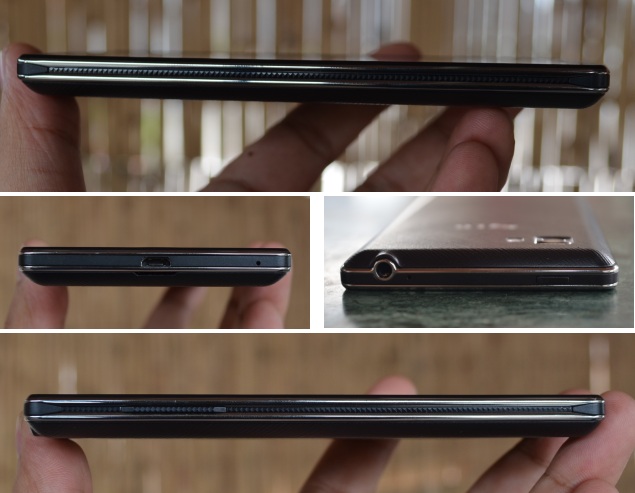
The
phone is huge, mainly because of the 4.7-inch display on-board, but is
still comfortable to hold unless you have very small hands. It is all
black (white version also available) apart from the two silver strips
running on the edge of the smartphone.
The volume rocker has been
intelligently hidden on the left side such that you won't even notice
it the first time. The power button is located at the top along with
3.5mm headset jack, and Micro-USB port is present at the bottom of the
smartphone.
The build quality is solid and the smartphone feels
nice in hand thanks to the rubberised and textured back. The front of
the device is covered with single piece of Gorilla Glass to help with
you with scratches and occasional falls.
Overall, LG has made one
great piece of hardware; it might not go down in the history books but
the hardware is unlikely to dissapoint anyone either.
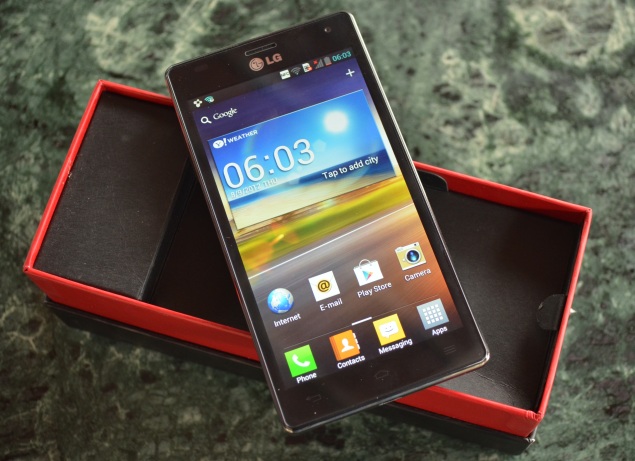
Display
720p
displays have become the standard these days and anything less would
not do justice to the 4.7-inch screen on LG Optimus 4X HD. The device
sports an IPS panel, which provides great colour reproduction and
viewing angles.
Despite being good in its own right, the display
still falls short of the superb HTC One X display, but only because the
One X has set a very high standard. Optimus 4X HD still is a great
display and one of the best that you will find outside One X.
Camera
Similar
to other flagship smartphones, LG has also included 8-megapixel rear
camera and 1.3-megapixel front camera in Optimus 4X HD. The image output
from the rear sensor is pretty nice and the resulting images are quite
good. However one issue that plagues the Optimus 4X HD camera software
is its nature to lose manual focus after every 2-3 seconds. So if you
tap to focus on an object in your frame, the phone will initially focus
on that but switches to auto-focus after two-three seconds. This is, of
course, pretty irritating and had us rushing to click photographs before
the dreaded auto-focus kicked in! We couldn't find any preference to
disable this behaviour.

Overall, the camera software is quite
simple, yet decent, but does not offer extra features like the funky
Instagram kinds of effects present in One X. However the options to
tweak ISO, White Balance, and Scene mode are present.
The camera supports full-HD recording and also allows you to add funny face/ background effects during live recording.
Software/ User interface
One
of the biggest positives for Optimus 4X HD is the revamped Optimus UI
on the smartphone. It is far better than the previous versions.
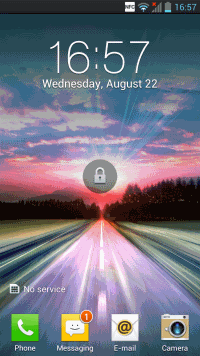
The
Korea manufacturer has finally got it (almost) right. The same skin is
present on all other Ice Cream Sandwich smartphones from LG, so even if
you don't go for 4X HD and opt for cheaper ones like L5 and L7, you will
still get this nice UI.
Starting from the unlocking your phone,
to making a call or browsing the web, the user interface is pretty
decent and most of all, fast. Well, the fluidity can also be attributed
to the beast quad-core processor on-board, but still it is some nice
work from the folks at LG.
Apart from the cosmetic changes by LG, the interface seems pretty stock, unlike HTC's Sense interface.
The
new LG lockscreen is also worthy of mention. Unlike the stock ICS way
of swiping the lock sign to unlock, on Optimus 4X, you put your finger
anywhere on the screen and a circular translucent window to your
home-screen opens up. When you swipe away that circle, your phone is
unlocked. Lock-screen also hosts four app icons at the bottom, swiping
any of them from the lock-screen, takes you directly to that app, which
is pretty useful when you are in a hurry to make a call or send an SMS.
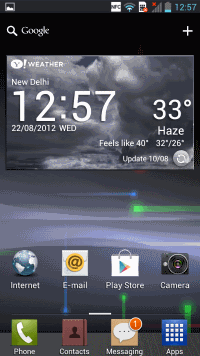
LG
also allows make several customisations to home-screen. Some of them
are ability to apply one of the four themes, or changing the home screen
effect.
One software enhancement that we particularly liked on
Optimus 4X HD was the inbuilt comprehensive backup mechanism that allows
you to backup or restore apps, bookmarks, calendar, call log, contacts,
home-screen or system settings to the device memory or SD card.
In
terms of the pre-loaded apps, LG has included SmartWorld (extra app
store), SmartShare (DLNA app), RemoteCall Service (remote servicing
tool), Quickmemo (note app) and MediaHome (a dashboard for all
multimedia content on your phone).
Similar to Sony's SmartTags, LG
is also bundling a NFC sticker, which allows you to change system
settings to a predefined set by simply tapping your device to that
sticker.
Performance/ Battery Life
Be it HTC One X or LG
Optimus 4X, there are no doubts about performance of Tegra 3. This
quad-core processor is a performance beast and that has been proved
again and again. Everything is just snappy on Optimus 4X HD.
Thanks
to the stockish interface, the 1GB RAM on-board is not bogged down,
which means that despite opening multiple apps, the phone remains butter
smooth (not Jelly Bean's Project Butter kind, but the best you can get
on ICS).
It is the best performance we have seen so far of any LG
Android device and amongst the best across Android devices from any
manufacturer. The Korean company has certainly stepped up its game big
time and the Optimus 4X HD marks its entry into the big league of
power-phone makers.
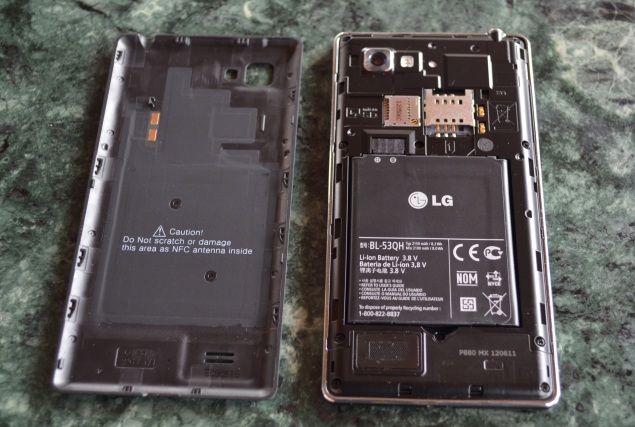
On the gaming front as well, as expected, the phone did not show any sign of strain during Shadowgun or Dead Trigger sessions.
That
brings us to the tricky part. If you bundle a quad-core processor and
720p display, it is likely that your battery will not last very long.
The 2100 mAh battery in Optimus 4X HD will just about get you a day's
worth of juice with normal usage.
With multi-core processors and
HD displays in our smartphones, we really need some breakthrough
innovation in the battery technology to take us to the next level.
Verdict
The
last few high-end smartphones from LG haven't really clicked with
consumers and LG is the only one to blame. However, the company seems to
have finally got it right with Optimus 4X HD. Right from the presence
of Tegra 3 to great software and elegant design, LG Optimus 4X HD ticks
all the right boxes.
Overall, the Korean manufacturer has released
a great Android smartphone, maybe not at the same level as the One X
and the Galaxy S III, but certainly a worthy contender nonetheless.
For more images of LG Optimus 4X HD check out our gallery.
Price: Rs. 34,490
Pros
- Great performance
- Elegant design
Cons
- Focus issue in camera
- Battery life
Ratings (Out of 5)
Design: 4
Display: 3.5
Performance: 4.5
Software: 4
Battery Life: 3.5
Value for Money: 4
Camera: 4
Overall: 4
Microsoft CEO sees company becoming more like Apple
3:11 AM |
Microsoft Corp Chief Executive Steve Ballmer has signaled a new
direction for the world's largest software company, pointing to hardware
and online services as its future, taking a page from long-time rival
Apple Inc.
Ballmer's comments in his annual letter to shareholders
published on Tuesday suggested that Microsoft may eventually make its
own phones to build on its forthcoming own-brand Surface tablet PC and
market-leading Xbox gaming console.
"There will be times when we
build specific devices for specific purposes, as we have chosen to do
with Xbox and the recently announced Microsoft Surface," wrote Ballmer.
The
new approach mimics Apple In, whose massively successful iPhone and
iPad demonstrated tight integration of high-quality software and
hardware and made Windows devices feel clunky in comparison.
Ballmer,
who took over as CEO from co-founder Bill Gates in 2000, said the
company would continue to work with its traditional hardware partners,
such as Dell Inc, Samsung and HTC, but he made it clear that Microsoft's
role in the so-called 'ecosystem' was changing.
"It impacts how
we run the company, how we develop new experiences, and how we take
products to market for both consumers and businesses," he wrote.
Microsoft
already makes money from providing services online, such as access to
servers to enable 'cloud computing', or Web versions of its Office
applications, but Ballmer's new emphasis suggests an acceleration away
from its traditional business model of selling installed software.
"This is a significant shift, both in what we do and how we see ourselves as a devices and services company," he added.
Bonus clipped
Alongside
the shareholders' letter, Microsoft's annual proxy filing, which deals
with the shareholders' meeting and other governance issues, showed that
Ballmer, 56, got a lower bonus than he did last year, partly for flat
sales of Windows and his failure to ensure that the company provided a
choice of browser to some European customers.
He earned a bonus of
$620,000 for Microsoft's 2012 fiscal year, which ended in June, down 9
percent from the year before, according to documents filed on Tuesday
with the U.S. Securities and Exchange Commission.
His salary, which is low by U.S. standards for chief executives, remained essentially flat at $685,000.
It is the third year in a row that Ballmer has not earned his maximum bonus, set at twice his salary.
Microsoft's
recent financial year was scarred by a $6.2 billion write-down for a
failed acquisition and lower profit from its flagship Windows system as
computer sales stood still.
In the company's filing, Microsoft's
compensation committee said it took into account a 3 percent decline in
Windows sales over the year, as well as "the Windows division failure to
provide a browser choice screen on certain Windows PCs in Europe as
required by its 2009 commitment with the European Commission."
Microsoft's
failure to provide a browser choice in Europe was an embarrassing
setback for the company, which has been embroiled in disputes with
European regulators for more than a decade and paid more than $1 billion
in fines for including its own Internet Explorer browser on Windows. It
now faces further fines from a new investigation.
Separately,
Microsoft said that independent lead director Reed Hastings, the CEO of
online video rental company Netflix, would not seek reelection at the
shareholder meeting in November. A new lead director will be chosen at
the meeting, Microsoft said. Hastings, 51, said he wanted to focus on
Netflix and his education work.
Nokia Lumia 610 review
3:08 AM |
Nokia
is looking to make a comeback in the smartphone market by pinning its
hopes on Windows devices. Initially revealed at the Mobile World
Congress this year, the Lumia 610 hit Indian shores in July. The Nokia
Lumia 610 is the most affordable Windows device from the Finnish handset
maker. But the question is can this inexpensive Windows Phone device
offer the same fluid experience as the others in its family? We take a
look.
Hardware/ Design
The device sports decent looks
that you wouldn't be embarrassed carrying around. We reviewed a
magenta-coloured 610, packed in a big blue box with minimalist contents.
The more traditional users can opt for White or Black. Cyan is another
available colour. Box contents include a charger to be used with the
provided Micro-USB cable, a pair of headphones and printed manuals.
On first impressions, the Lumia 610 looks and feels just like the 710 with similar dimensions and weighing about 133 grams.
The
device has tinted chrome edges gives a metallic illusion but is
plasticky. It does have a sturdy build and fits comfortably in the
hands. The design is such that the front and back sort of lock into each
other, hinting at a chin below the screen.
The power button is
located on the right along with the volume rocker and a dedicated
shutter button. Most of us are more used to the power/wake button
positioned on the top. It does get a bit uncomfortable when it is placed
on the side.

Moving
on, the top houses the headphones jack and the Micro-USB port. The back
features a 5MP camera with LED Flash situated on the top while the
loudspeaker grill is at the bottom. The left side of the device and the
base are clean with no buttons or ports.
The back panel's
matte-finish is easily prone to attract greasy stains and the screen is a
fingerprint magnet too. The panel slides off easily to reveal the
battery, under which is the micro-SIM card slot.
The front sports
the trio of capacitive Windows Phone keys for Back, Home and Search
that are spaced out well for single hand use and to avoid accidental
button presses.
Overall, the phone has a solid build and offers a trouble-free one hand user experience
The
Lumia 610 is powered by an 800MHz processor hosting 256MB RAM. It comes
with 8GB internal storage with no option for external expansion. The
best you can do is make use of the 7GB free storage offered by SkyDrive.
Display
The Lumia 800 has a ClearBlack AMOLED panel, while the 710 sports a ClearBlack TFT. But the cheaper Lumia 610 has neither.
The
device has a 3.7-inch LCD screen with a WVGA resolution translating
into a pixel density of 252ppi (480x800 pixels). Text is clearly visible
and the graphics look decent and smooth too.
But the phone has
major issues under the sun, with the screen looking pretty dull. At
maximum brightness levels, colours seem washed out, though readability
improves, but not much. Since the screen is highly reflective, you'll
find yourself using your palm to cover the screen.
Camera
The
Lumia 610 is equipped with a 5MP camera with LED flash. The dedicated
camera button is placed on the right. A gentle half-press will bring out
auto-focus while long pressing the button will activate the camera even
when the phone is locked. You can manually focus by just tapping an
area on the screen.
Colours of images appear washed out and those
taken under low light are noisy. Though videos are smooth with the
auto-focus working well here, they only produce VGA quality. The 710, on
the other hand, is capable of sharp 1280x720 videos.
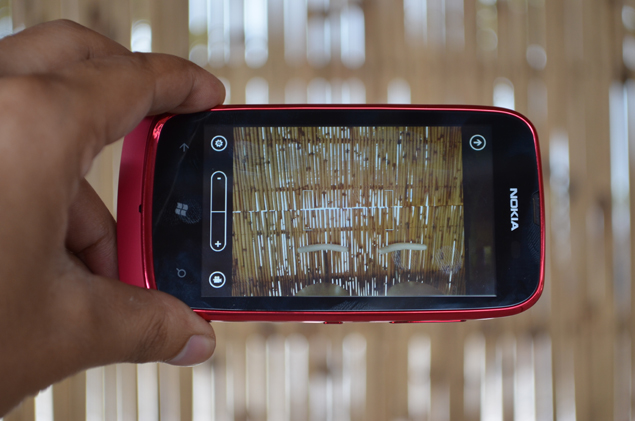
Using
zoom on the device decreases the detailing in the images. Shots appear
really blurry. It's advisable not to use the zoom. There's an 'auto-fix'
feature that comes quite handy to brighten shots taken in the dark or
under low light.
Basic camera settings are accessible once the
app is launched including Scene mode, White Balance, Flash, ISO settings
and more. There is no front camera on the device.
Software/ Interface
The
Lumia 610 runs on Windows Phone 7.5. Initially called Refresh, Windows
Phone 7.5 got updated to Tango at this year's Mobile World Congress. The
idea of the update was to power Windows Phone devices with lower
hardware specs.
Waking up the phone reveals the lock screen,
which is entirely covered with the wallpaper of your choice, also
displaying the date and the time. In case you've set reminders or
calendar events, those appear too along with email notifications and
missed calls. The signal strength and the battery indicator are
displayed on top.
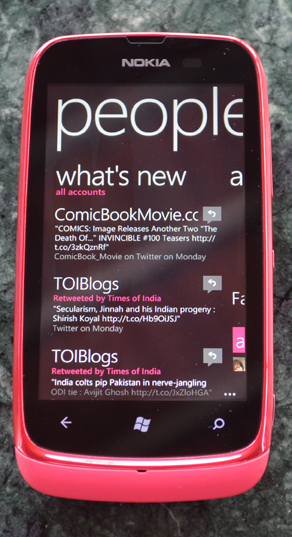
Swiping
up brings the rather crowded home screen with various applications in
gigantic tiles laid out vertically. The device features the live-tile
Metro user interface with two customizable home screens. You can change
the order of the tiles as per your liking. A swipe to the left launches a
second screen with the phone's stock applications. Any of these can be
pinned to the start screen by long pressing a particular app and
choosing the 'pin to start' option.
The settings screen and
search page are clones in terms of the design. There's a search bar at
the bottom of the screen, making it easier to browse new pages. A list
of options, including tabs, recent pages and favourites are accessible
by tapping a button on the bottom-right. This screen also enables you to
add a page to your favourites, pin it to your home screen or share it
on social networks. Bookmarks are shown as a text list, while tabs are
displayed as an image of each open page.
The Marketplace tile
shows available updates while the Photos tile displays a slideshow of
your pictures. You can view all installed apps under Applications, which
are alphabetically sorted. A search button integrated within allows you
to find apps more easily.
Switching between apps is easy. Just
hold down the Back key and scroll horizontally to jump into any one of
them. However, the list keeps refreshing as the older apps disappear and
are replaced by the more recently used apps. Killing these apps is not
possible.
The Messaging application on the Lumia 610 has some
interesting options to give you a satisfying experience. Social network
integration allows for easy swapping between messages, Facebook chat or
any other chat clients on your phone. All these messages appear as one
single thread.
Windows Phone 7.5 also has a voice assistant
that can be used for dictation; get replies to be read out to you or to
begin searches.
Apps such as Office and SkyDrive together are a
powerhouse of productivity. Office helps you to create, view and edit
documents stored on your device as well as those in the cloud. With
SkyDrive, documents between your phone and PC sync automatically.
Viewing
and editing documents in Office is absolutely free and integrated into
the OS. Word and Excel docs come with viewing and editing support but
PowerPoint files are for viewing only. SharePoint collaboration for
Word and Excel files allows you to attach those files to emails, though
you need to do that from the Office hub and not the e-mail editor.
Microsoft's
note-taking application OneNote, is very easy to use and lets you add
photos and voice memos which can then be sent via email. You can also
sync OneNotes with your SkyDrive or Windows Live account to access them
from anywhere.
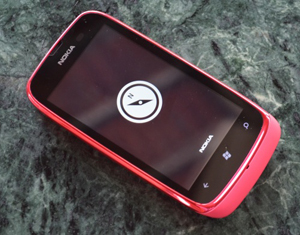
Other
pre-installed apps include Nokia Maps and Nokia Drive and both
functioned pretty well. While the former is an alternative to Bing Maps
(also available on the phone), Nokia Drive makes navigation as simple as
it can get. The voice-guided app lets you zoom in and out depending on
your preference to see more details of the road ahead.
Whenever
you approach a turn, it is indicated at the top of the screen in big,
easy to read white lettering with a viewable icon noting the turn. The
bottom of the screen shows the time remaining and current speed, which
appears to the left side of the screen in portrait mode. Nokia Drive
also lets you view downloaded maps in offline mode.
It is worth pointing out that the Nokia Lumia 610, like other phones running Windows Phone 7.5, will not get the Windows Phone 8
upgrade, so they stand to miss out on a lot of great features. Instead,
they will get the Windows Phone 7.8 upgrade, so if you care about being
on the latest version of the OS (as you should), you're not going to
get that here.
Performance/ Battery life
For being
dubbed as the cheapest Windows Phone device, the Lumia 610 delivers a
decent performance. It is slow at times, but nevertheless runs smoothly.
Call quality on the phone is good with clear reception with
even just one or two bars of signal strength. Connectivity wise, the
phone performs well over both 3G and Wi-Fi networks.
The QWERTY
keyboard is quite responsive but accidental button presses can't be
avoided since it feels squeezed in both portrait and landscape modes.
The 1300mAh battery on the device squeezes enough juice to last for
almost 2 days.
Storage comes across as a notable flaw in the
device. With just 8GB of on-board storage and no support for external
expansion, intensive apps with specific memory needs like Angry Birds
and Skype won't install. Microsoft is looking to address the issue and
states that most apps should deliver a satisfying experience on 256MB
RAM devices.
A feature highly missed is the ability to take
screenshots. But Microsoft has promised that this feature will be
included in its latest Windows 8 version.
Verdict
The
Lumia 610 comes with its own strengths and weaknesses. The biggest
attraction for the device has to be its price. For an entry level
Windows phone, the device can be a hit for prospective buyers. Apart
from offering a great battery life, the device gives you almost a
holistic Windows Phone experience packed in a sturdy build.
That
said, the phone pinches you when it comes to storage and compatibility
issues while finding apps that don't run. So app hungry users will be
disappointed. The camera is a let down too and serves handy only for
emergency purposes. A slight sluggishness is felt when launching apps.
Though the handset makes its share of sacrifices, it does deliver a
worthwhile user experience.
As we pointed out earlier, there is
no upgrade path to Windows Phone 8 for current Windows Phone devices
like the Lumia 610, so you may want to wait until Windows Phone 8
devices hit the market (we strongly recommend that).
Price: Rs. 12,999
Pros
Value for money
Battery life
Cons
No microSD card slot
Poor camera
Ratings (Out of 5)
Design: 3
Display: 3
Performance: 3
Software: 3
Battery Life: 3.5
Value for Money: 3.5
Camera: 3
Overall: 3
Apple iPhone 5: First look
2:58 AM |
As I played around with the iPhone 5 on Wednesday, I wondered what the
late Steve Jobs would have thought about the latest twist on Apple's
best-selling device.
It didn't take long to conclude Jobs would have been delighted with the iPhone 5's blend of beauty, utility and versatility.
Add
in the more advanced technology and new features that went into this
iPhone, and it's clear Apple has come up with another product that will
compel hordes of people to line up outside its stores before its Sept.
21 release in the U.S., Japan, Britain, Germany, France and four other
countries. The mad dash to buy the iPhone 5 will be repeated again on
Sept. 28 when it goes on sale in 22 other countries. All the models of
the iPhone 5 will sell for the same prices as its predecessor, starting
at $199 with a two-year data and calling plan.
An important caveat
about these impressions: I was only allotted about 15 minutes with the
iPhone 5 at Wednesday's launch event, not enough time to discover if it
might have some technological bugs. I am sure in the coming days other
reviewers will have the opportunity to give the phone a more thorough
vetting.
For many people, the iPhone is going to be a case of love
at first touch. It's incredibly light and seems to be easier to hold.
That means it might not be dropped as frequently as previous iPhones,
reducing the chances of the glass on the display screen getting damaged.
One
woman who also was testing out an iPhone 5 couldn't stop raving about
how ideal the new design was for people with smaller hands. "All the
other iPhones were made with men in mind because they could easily slip
from your grasp if you didn't have big hands," she said. "Now we finally
have an iPhone for women."
The new iPhone also is easy on the
eyes, thanks to a larger screen and its "Retina Display," the
high-definition technology that Apple introduced in previous models.
Video and photos look even more lush on the iPhone 5's bigger and better
screen.

At 4 inches diagonally, the iPhone 5's screen is a
half-inch larger than previous generations and Apple make sure to take
advantage of it. On the more prosaic side of things, the extra space
means you can now see five rows of apps on the home screen instead of
the previous limit of four rows. Open the calendar and you can see five
days of events on the screen in horizontal mode, instead of just three.
The
larger screen really comes to life, though, with what is perhaps its
coolest feature - a tool called "Panorama" that automatically stitches
together a series of pictures into a majestic vista. Panorama can be
turned on simply by going into the iPhone 5's camera mode and then
selecting it on an option menu. Once it's activated, an arrow guides you
as you slowly pan the camera around whatever scenery you desire (if you
move too fast, Panorama tells you to slow down and also advises you if
you are moving the camera too high or low). Once you are done, you can
look at the panoramic shot within seconds and zoom into whichever areas
of the picture look most interesting.
Not surprisingly, watching
video on the larger screen is also more pleasurable, although I still
think the iPad and other tablet computers are a much better way to watch
movies and TV shows on the go.
The device is also speedier
because of a more powerful processing chip and upgraded wireless
technology that accelerates Web surfing.
Apple also has equipped
the iPhone 5 with a superior sound system, courtesy of the new
headphones that the company says it spent three years developing. The
headphones, called "EarPods," are a vast improvement on the ear buds
that Apple has been giving away with its devices for more than a decade.
The new headphones actually stay in your ears and make it seem as if
the sound is playing inside your head. The EarPods come free with the
iPhone 5, and they sounded as good as $100 headphones sold by a variety
of other companies.

The new phone's operating system, iOS 6, also
introduces another fun toy that makes it easy to share photos with your
friends and family. Just select a picture, or even a series of photos,
then email them to whomever you want. Assuming the recipients also has
an Apple device running on iOS 6, they will get a notification that will
send the designated photos to their iPhone, iPad or iPod Touch. The
recipients don't necessarily have to own an iPhone 5 because the new iOS
can be downloaded for free beginning Sept. 19 on a wide range of older
Apple devices, including the three previous versions of the iPhone and
the last two versions of the iPad.
The new operating system also stands out for what's missing.
The
pre-installed YouTube app that had been part of the iPhone since it
came out in 2007 is gone (you can now download a new application made by
YouTube owner Google Inc. in Apple's iTunes store). Even more
noticeable is the absence of Google Maps. Apple has cast aside one of
Google's most popular services for its own mapping system and, from what
I saw, it looks like it's going to keep users happy. It offers
three-dimensional renderings of many major cities, aerial views, and,
best of all, turn-by-turn directions narrated by the iPhone's virtual
assistant, Siri. Assuming the directions are accurate, I doubt Google
Maps is going to be missed.
The new iOS also offers a feature
called "Passbook," where digital coupons, airline tickets and gift cards
can be conveniently stored in one location. This, too, is going to be
popular. Yet, Passbook would be an even handier tool if the iPhone 5
boasted a near-field communication chip to enable wireless payments at
the checkout stands equipped for the still-nascent technology. Some
phones running Google's Android software are able to process payments
because they have the NFC chip.
Siri is also supposed to be
smarter and even more helpful in the iPhone 5, although I didn't get a
chance to challenge her in Apple's noisy testing room.
Too bad
because I would have liked to ask Siri what Steve Jobs might have
thought of the iPhone 5. But, I am pretty sure I know the answer.
Mobiles playing an important role in US politics - study
1:50 AM |
A growing number of Americans are using mobile phones to keep up with or
play a role in politics, but some say they are getting unwanted
political messages, a study showed Tuesday.
The Pew Internet &
American Life study showed some voters are using smartphones as
real-time fact-checkers or to post political messages to social
networks.
The report found 88 percent of registered voters own a
cell phone of some kind as of September, and 27 percent of the phone
owners used the devices to keep up with campaign news or political
issues in general.
Nearly one in five have sent text messages
related to the campaign to friends, family members, or others and five
percent have signed up to receive text messages directly from a
candidate or other group.
But five percent said that they have received unwanted election-related text messages that they did not sign up to receive.
Forty-eight
percent of the voters surveyed said they have a smartphone, and within
the group, 45 percent have used the device to read comments on a social
networking site about a candidate or the campaign, and 35 percent have
checked the truth of campaign statements, the study found.
Among
smartphone-owning voters, 18 percent have used the device to post
comments on social networks about a candidate or the campaign, the
survey showed.
Mobile apps are playing a relatively minor role in
the campaign, according to the Pew report. It found 45 percent of
cell-owning registered voters use apps, but just eight percent of them
use apps from a candidate, political party, or interest group.
The
survey conducted September 20-23 interviewed a sample of 1,005 adults
including 872 cell phone owners, 731 of whom are registered voters.
Kindle Fire HD
1:12 AM |
The Kindle Fire HD 7" tablet is Amazon's follow-up to the successful $199 Kindle Fire
(now reduced to $159 and rechristened the Kindle Fire SD). The HD Fire
improves just the things we wished for as first gen Fire users, but
it's not the power monster that the also $199 Nexus 7
is. That's fine with us because the tablets aim for two very different
kinds of users. The Kindle Fire HD is for those who want a tablet
primarily for easy content consumption; and that means Amazon's
ever-popular content plus services like Netflix, HBO Go and Hulu Plus.
In fact, you can even side-load the Android Nook app if you like!
The Kindle Fire HD runs Android OS
4.0.3 Ice Cream Sandwich, though you'd barely guess from looking at
Amazon's highly customized user interface with the big carousel of
content and tidy bookshelves. That UI is largely unchanged from the
first Fire. No geeks, there's no way to make this look like standard
Android without hacking the tablet or side-loading alternate Android
launcher apps. It has a very sharp IPS 1280 x 800 Gorilla Glass display
that's very noticeably better than the 1024 x 600 Kindle Fire SD
display. Movies look so much better! Text in books is extremely sharp
and clear. Graphically rich magazines in page view mode actually have
readable tiny text.
The Fire HD has a new dual core TI OMAP
4460 CPU clocked at 1.2GHz, and the tablet feels more responsive, though
that may in part be due to better software tuning. On Quadrant, it
scored 2174, which was par for the course among last year's Android
tablets, but falls way behind the mid to upper 4000's we see in Tegra 3
tablets and Qualcomm Snapdragon S4 used in 2012 Android smartphones.
Still, that's a bit faster than the original Fire and it's more than
adequate to power the apps and services on the Fire HD. High quality
movies render fine without stalling (the dual band WiFi with MIMO
certainly helps too), web pages render much more quickly and games run
smoothly. The UI lags less than on the first generation Fire.
Design and Ergonomics, Video and Audio
In terms of looks, Amazon isn't going to
turn out a design contest winner for $199. That said, this is a very
nice looking tablet, though it still manages to look chunkier than it is
(at 0.4", it's the same thickness as the Nexus 7 but appears thicker).
The tapered sides look modern and attractive and we like the racing
grille that traverses the soft touch back and showcases the excellent
stereo speakers with Dolby audio. The bezel is wide and that makes the
13.9 ounce Kindle Fire HD look less modern and aggressive, but
ergonomically it gets the job done by giving you a place to grip the
unit when reading.
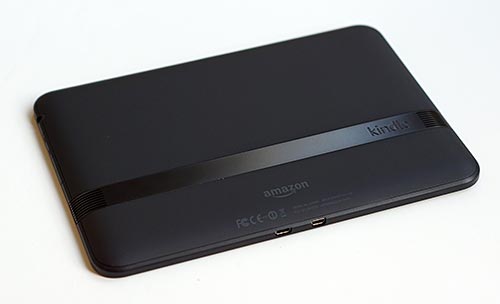
The Fire HD has a micro HDMI port,
Bluetooth 4.0 and a front video chat camera: all important additions as
well as features the first Fire lacked. The micro HDMI output good
quality audio and video in our tests with a Sony AV receiver, and we
were able to watch Amazon Prime videos on the big screen using the
tablet.
The Fire HD has a micro USB port so you
can charge the tablet and transfer content to the tablet (books, music,
videos and personal files). You can also use Amazon's unlimited cloud
storage service to transfer content to the tablet and stream anything
you've bought from Amazon, obviating the need for more internal storage
or an SD card (the HD Fire models lack SD card slots). Amazon includes a
USB cable in the box but no charger. You can charge over USB, use your
smartphone's charger or buy Amazon's pricy $20 Kindle Fire HD charger.
While we understand that manufacturers omitted E-Ink reader chargers to
bring the price down (E-Ink readers require charging only once a month
on average and require fairly low amps to charge quickly), it's a little
disappointing that Amazon left it out for this much more power hungry
LCD based device.
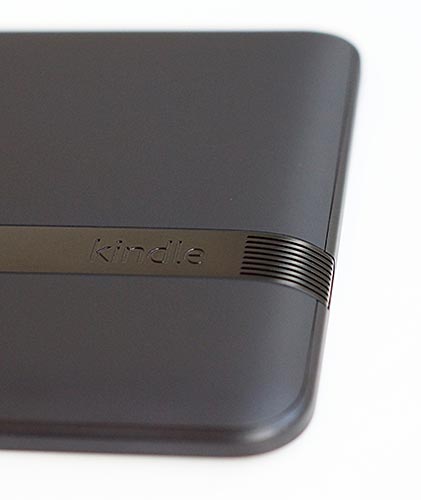
The front camera delivers surprisingly
sharp and bright video when using the included Skype for video chat.
It's one of the better mobile video chat cameras on the market, and the
only thing that reduces quality is if you walk around while chatting
(the camera has a hard time keeping up with quick background changes and
sends out blocky video). The mic picked up our voice and sent clear
audio to our chat partner. Incoming audio was likewise clear and
reasonably loud. You can also use a wired or Bluetooth headset for
chats.
Amazon Kindle Fire HD Video Review
|
Audio
We rarely devote a section to a tablet's
speakers, but the Kindle Fire HD has remarkably good stereo speakers
with Dolby audio. Not only are they a vast improvement over the meek
original Fire speakers, they're full and rich sounding. While the first
Fire wasn't loud enough to overcome the whirring of my exercise bike in
an otherwise quiet room, the Fire HD manages just fine. That's important
for a device that's designed to present both music and video. In fact,
music is actually enjoyable through the speakers rather than sounding
like the muted, hissy mess that we hear from most 7" tablets including
the Nexus 7. For even better sound, plug in a decent set of stereo
headphones or speakers. You can even use Bluetooth stereo speakers with
the Fire HD.
Performance and Horsepower
The dual core TI OMAP 4460 CPU runs at
1.2GHz. That's the same CPU used in the Samsung Galaxy Nexus, and it was
the launch platform for Ice Cream Sandwich at the end of 2011. The Fire
HD has PowerVR SGX 540 graphics for decent though not cutting edge 3D
performance. It handily outperforms the Nvidia Tegra 2's GPU, but can't
touch the 12 core GeForce GPU in the Tegra 3. The Fire HD has a much
more workable 1 gig of DDR2 RAM vs. the 512 megs on the first Fire. The
tablet is available with either 16 or 32 gigs of flash storage (a high
quality Samsung eMMC according to the iFixit teardown).
Despite Jeff Bezos' hype, the Kindle
Fire HD isn't going to set new speed records for Android tablets. Far
from it. But it is more than fast enough to get the job done, from HD
video playback to gaming. Web browsing speeds are as good as on devices
with much faster CPUs, and games on the Amazon App Store played
perfectly. This isn't a tablet for cutting edge geeks who crave the
fastest silicon in production. It's here to get a job done, and it does
that job just fine.
Benchmarks
Software
Really, little has changed from the last
gen Kindle Fire, but we'll note the new features here. The Fire HD now
has access to X-Ray for movies, so you can get info about the movie and
actors when watching an X-Ray compatible Amazon video. You can read a
book while listening to it read aloud via text to speech and now with
Audible companion books too. There's Whispersync to keep your place in
books, movies and audiobooks. In fact, Whispersync can save your place
in compatible games too via the new GameCircle that also handles social
gaming.
We're thrilled that the Fire HD has
calendar and contacts applications that can sync to Google, and the
email client (pretty much the standard Android email client) can pick up
POP3/IMAP/Exchange/Yahoo/Gmail/AOL and other popular email sources.
And for something controversial: the
Fire HD models are ad sponsored. That means you'll see an ad when you
wake up the device. If you swipe the double-ended unlock bar left to
right, you'll get more info about that ad (a special offer, a trailer
for an upcoming movie or TV show, even a free $5 to spend on the Amazon
MP3 store). If you swipe right to left (grab the lock symbol and swipe),
you'll go back to whatever screen you left off on. Amazon will make
your Fire HD ad-free if you pay them $15.
Yes, you can side-load apps that you've
downloaded to your smartphone or tablet and transfer them to the Kindle
Fire HD, but it takes some know-how (and rooting) of your other device
to extract apps from it to transfer to the Kindle. You can also search
the web for the apps you're interested in, and you may find them
available for download from places other than the Google Play Store.
Peruse the Amazon App Store from your computer's web browser: if you
find key apps missing, the Fire might not be for you.
The Kindle Fire HD is rootable, though
the bootloader is securely locked. Root access opens up possibilities
for installing the Google Play Store and enabling login in other
side-loaded Google apps.
The Amazon Kindle Fire HD vs. the Google Nexus 7
This decision might be easier than you
think. These two tablets are designed with very different users in mind.
It used to be that geeks on a tight budget who wanted a good quality
general purpose 7" tablet had to buy and root a Nook Tablet
or Kindle Fire. Thanks to the Nexus 7, that's no longer necessary.
Being a Google pure experience device, the Nexus 7 not only has full
access to the wide range of Google apps and services like Gmail, Maps
and the Google Play Store, but it's easy to root and load custom ROMs.
If that makes you grin madly, then the Nexus 7 is for you. If you could
care less about Google's app store and don't know root from ROMs, but
you do want to read eBooks, stream video in high quality and listen to
music, then the Kindle Fire HD is for you.
Both are roughly the same size and
weight (the Nexus 7 is 1.9 ounces lighter), but each tablet has hardware
strongpoints. For the Kindle Fire HD these include excellent stereo
speakers with Dolby audio, an HDMI port and strong dual band WiFi. For
the Nexus 7 it's the GPS (the Kindle Fire HD, like the non-3G/4G iPad
can only use WiFi triangulation for location services, though there is a
GPS chip that's not currently enabled in software) and a much faster
CPU.
For $199 you get 8 gigs of storage on
the Nexus 7 ($249 for 16 gigs), while the Kindle Fire HD has 16 gigs for
$199 and 32 gigs for $249.
Both have access to MS Office compatible
suites, should you wish to get work done. Both have PIM apps and an
email client. The Fire HD doesn't have a dedicated Gmail cliient though,
you have to use the email client to pick up Gmail.
Amazon's customer support is stellar;
it's the best in the business (OK, Apple's is also top notch). Google's
support is very weak and Asus' is passable.
Most importantly: if you want a fast,
general purpose tablet with access to the Play Store and Google's other
services and markets, get the Google Nexus 7 by Asus. If you want a
turnkey device to consume books, magazines, movies from Amazon, Netflix
and Hulu and music, get the Kindle Fire HD.
Battery Life
The Kindle Fire HD has a 4400 mAh
Lithium Ion battery that's sealed inside. As mentioned, it doesn't come
with a charger so you'll either use your smartphone charger or buy
Amazon's $20 charger. The company claims 11 hours of use with mixed
tasks that include web browsing, reading books, watching video and
listening to music. In our tests, that's proved accurate and the Fire HD
outlasts the admittedly robust Nexus 7 (to be fair, the Nexus 7 has a
much faster CPU with twice the cores so it needs more power).
Conclusion
It's hard to not like the Amazon Kindle
Fire HD. It excels at its purpose as an affordable one-stop device for
reading Amazon books and magazines, streaming video, playing music and
providing you with a safe (albeit somewhat limited) app store. It's
brain-dead easy to use, Amazon provides excellent support and their
various stores have more than enough content to keep you entertained for
the next 20 years. The IPS display is very sharp and has excellent
viewing angles, the speakers are awesome for a 7" tablet and battery
life is very good. It's everything that a purpose-built entertainment
tablet should be. Just remember, it's not designed to be a general
purpose Android tablet.
Price: $199 for 16 gig model and $249 for 32 gig model
Website: www.amazon.com
|
Amazon Kindle Paperwhite
1:08 AM |
Amazon has Kindle models for everyone: touch screen
Kindles, keyboarded Kindles, LCD tablet Kindles and now the Kindle
Paperwhite with a side-lit E-Ink display. The Paperwhite competes with
the Barnes & Noble Nook Simple Touch with GlowLight
and it uses a somewhat similar technology to provide lighting to a
display that's useless when you're trying to read in dim light or the
dark.
The Paperwhite is a 6" eBook reader that
supports Amazon's AZW and MOBI formats as well as PDFs. It weighs less
than 8 ounces and is very thin. The design is a minimalist soft-touch
black slate that looks modern and feels good in hand, though the small
bezel might not be comfy for those with large hands (it works fine with
my fairly large, long-fingered hands). There are no hardware page turn
buttons, and in fact the only control is the power button on the bottom
edge. Typical of Kindles, there's no expansion card slot, and that means
you'll have to make do with the 2 gigs of internal storage and Amazon's
cloud storage services (you can download a book, magazine or newspaper
from the cloud, delete it from the Kindle when done, and re-download it
should you wish to read it again).
E-Ink readers are returning to their
single-purpose roots and there's no music player or Audible book support
here. In fact, there's no speaker and no headphone jack (the Kindle Keyboard and the outgoing Kindle Touch had audio but not the non-touch Kindle 4
that now sells for $69). The "experimental" web browser and social
sharing of what you're reading are the only non-reading functions. Like
all recent Kindles, the Paperwhite comes with a dictionary and you can
also look up words and passages in a book using the Wikipedia or
Amazon's X-Ray service and you can translate words and passages with
Bing.
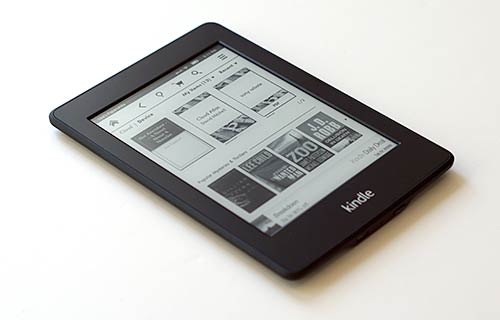
The Kindle Paperwhite starts at $119
(with ads) for the WiFi model. The WiFi+3G model is $179. If you don't
want to see ads as your screensaver, you'll have to pay Amazon an
additional $20 to turn them off.
Display and Frontlight
The name Paperwhite is fitting, because
this is the whitest display we've seen yet on an E-Ink reader. That
doesn't mean it's pure white; even printed book pages aren't perfectly
white. But when lit it's much less gray looking than E-Ink readers
without sidelights and it lacks the Nook GlowLight's sickly florescent
blue-purple tinge. By default, the sidelights (also called frontlights)
are turned on, and happily they don't destroy the Kindle Paperwhite's
superb battery life (Amazon claims up to 2 months on a charge, and so
far we'd estimate a month if you read an hour per day with the light
turned on). In weak to moderate ambient lighting, the page appears
uniformly lit even though the lights emanate from the bottom edge and a
nano-imprinted light guide (diffuser) spreads the light across the
virtual page. The lighting is more even than the Nook GlowLight, whose
LEDs are at the top edge. In a very dimly lit to dark room, you can see
the LEDs as a small strip of uneven lighting at the bottom edge of the
Kindle's display (watch our video to see this). In a perfect world, this
wouldn't happen, but technology is rarely perfect. Is it very
distracting? Not to our staff or me. In fact, it's much less distracting
than the Nook's uneven lighting or a booklight's uneven lighting and
glare.
The Kindle Paperwhite uses a capacitive
touch screen that's rarely used on E-Ink eReaders (they use IR touch
sensors) but is common on smartphones and tablets. It's responsive and
quick, though honestly we've never had issues with the rest of the crowd
that uses IR sensors. The capacitive touch layer doesn't degrade
display contrast or clarity, nor does it make the text look "far away"
under layers of glass. The panel's texture is ever so slightly rough and
I love this because it feels more like a book's pages and it has more
tactile feel than slick glass.
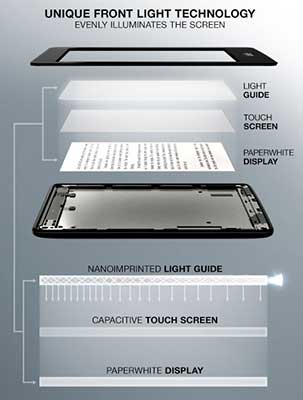
Happily, the display has excellent
contrast, even when the light is on. Yes, it has better contrast than
the competing Nook with GlowLight that suffers a contrast loss compared
to the Nook Touch And Kindle Touch. This is a sharper E-Ink display with
1024 x 768 resolution and a higher pixel density than the army of 6"
800 x 600 E-Ink readers on the market. That allows Amazon to offer some
nice new serif fonts like Baskerville and Palatino without fear of fonts
looking jaggy. Text looks better than on any other 6" E-Ink display
currently on the market, with smoother and sharper fonts. The page
refreshes every sixth turn by default, and the partial page refresh
leaves more ghosting than the Nook Glowlight and Kindle Touch. This is
more noticeable if you select something other than default Caecilia slab
(semi-bold) font. You can set the page to refresh with every page turn
if you don't mind the flash to black as the page turns or the small drop
in battery life. I'd love to see Amazon improve the partial page
refresh with a firmware update.
Amazon Kindle Paperwhite Video Review
|
The user interface is also
improved, and we finally have a book cover view instead of the archaic
list view (though list view is still available if you prefer it). The UI
feels as modern as the Nook and Kobo Touch,
and we thoroughly enjoyed using the Kindle Paperwhite. It also feels
noticeably faster than the Kindle Touch, despite the greater demands of
the more graphical UI. I'd still give the Nook Touch
and GlowLight models the edge for intuitiveness, but the Paperwhite is
pretty good. As with the Kindle Touch, all navigation is done on-screen
(there's no home button or hardware page turn buttons). Tap on the large
center to right side area to turn the page ahead, tap in the left
margin to go back a page. Tap near the top to bring up all controls and
settings. Pretty simple to master.
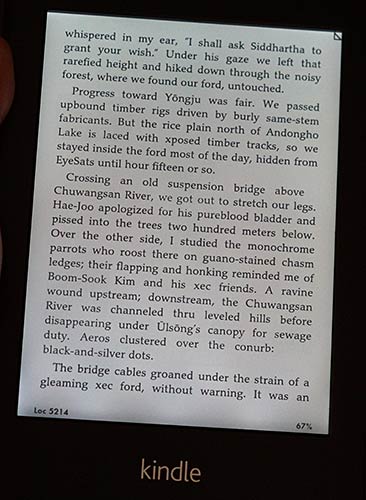
The usual staples are here like
X-Ray for books, highlights, notes, bookmark syncing across devices,
social sharing and cloud syncing of content (including your personal
content, not just Amazon books). The Paperwhite has 2 gigs of storage
with 1.25 gigs available, so you may find that cloud storage handy if
you run out of room (remember, there's no SD card slot).
The Kindle has a landscape option,
which is useful for PDFs whose text may be too small to comfortably
read in portrait mode. There's no zooming for PDFs, but you can enlarge
the font (which may disrupt the page layout). You can pan around the PDF
by dragging on-screen with a finger, but it's a slow process and I'd
choose an LCD-based device over a 6" E-Ink eReader for all but novels in
PDF format.
Bookstore and Shopping
As always with Kindle products,
you can either buy books using your computer's web browser and have them
sent automatically to the Kindle or you can shop directly on the Kindle
using WiFi or 3G. The store presentation is similar to other recent
E-Ink Kindles, with a mix of book covers and text links. It's easy to
search and buy content using the Kindle (the same is true of competing
eReaders from Sony and B&N). Amazon still stands out for their
absolutely immense selection of books and sometimes lower prices vs.
B&N, though these two large US booksellers often have the same
pricing, while the Sony Reader Store is a bit more expensive.
Amazon allows book lending (if the
publisher allows) with your Kindle-owning friends and Amazon Prime
customers have access to a decent free lending library run by Amazon
(you can check out one book at a time and hold onto it for as long as
you like).

The Kindle Paperwhite supports
Amazon's AZW and Mobi formats plus PDF. Those of you who wish to shop at
other ePUB bookstores are out of luck unless you're willing to use
Calibre to strip DRM and convert books to a Kindle-friendly format (it's
not hard, but breaking DRM is against US law). Public libraries now
offer Mobi and ePUB formats, but not all libraries have gotten up to
speed on Mobi offerings yet. Google's large selection of free public
domain works is in ePub format, but you can covert those using Calibre
(there's no DRM on public domain works so there's no worry over legal
issues).
Conclusion
Several reviewers have said that the
Amazon Kindle Paperwhite is the best E-Ink reader on the market and I
agree, with a few caveats. Not everyone wants the same things: some of
you may prefer ePub for its greater openness (you can buy books from
more sources), others of you may want a card slot or audio capabilities.
If you're happy with Amazon's huge selection of well-priced books or
you use Calibre to convert ePub eBooks to Mobi format for use on the
Kindle, then this is the best eReader on the market. I personally find
that 1.25 gigs of storage is more than adequate to carry a vast library
of books with me, so I don't miss the card slot. I prefer the thin and
modern Paperwhite design to the bulky Nook Touch and Nook GlowLight
design. But those of you with large hands and a hankering for hardware
page turn buttons will disagree. The display and frontlighting are the
best on the market, and that's arguably the most important feature on a
single purpose digital book reader. Battery life is likewise excellent,
and those of you who've been using an LCD based tablet or smartphone
will find the month or more of battery life liberating.
Price: $119 for WiFi version, $179 for WiFi + 3G version
Website: www.amazon.com
|
HTC Desire VC review
2:44 AM |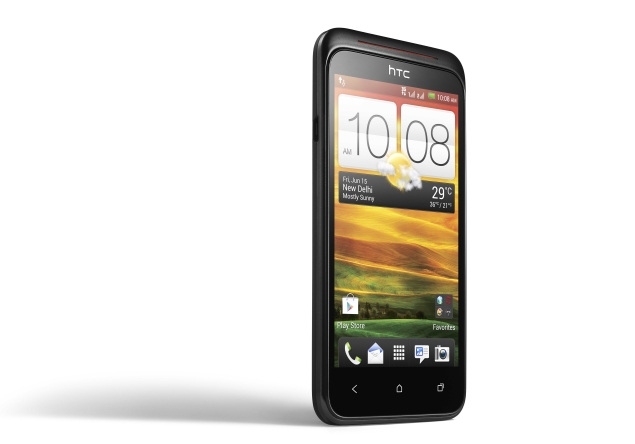
Off late, HTC has been quite aggressive in getting its One and Desire
line-up in India. The latest smartphone to join the league is HTC Desire
VC. This is the first dual-SIM smartphone from HTC that runs on Android
4.0 and supports both GSM and CDMA functionality. In terms of specs,
this device is very similar to the HTC One V but whether or not it
performs at par or better than the One V is something we shall find out
in our review.
Hardware/ Looks
The HTC Desire VC is a
good-looking smartphone. At 9.5mm, it is pretty slim and sleek and
lighter too weighing just 119 grams. The outer body seems to be made of
plastic, however it does not look cheap and feels rather sturdy. There
is a rubberised texture on the back panel, which allows for a
comfortable grip.
Most of the front screen is taken by the 4-inch
touch screen, which is large enough to read emails, browse the net and
even watch videos. The bottom houses three capacitive standard Android
buttons for Back, Home and Recent. The left panel houses the
Micro-USB/charging port while the right has the volume rocker keys.
The
back panel features a 5-megapixel camera with LED flash and the speaker
along with the Beats Audio branding. The top of the device has the
standard 3.5mm headphones jack and the power/wake button while the
bottom has the microphone.
Considering that it is a high-end
dual-SIM smartphone, we were expecting its SIMs to support hot swap but
that is not the case here.
HTC Desire VC packs in 1 GHz Cortex-A5 processor and 512 MB of RAM and there is a 1650 mAh Li-Ion battery on board.
Display
The
4-inch capacitive touch screen has a 480x800 pixels resolution
translating into pixel density of 233 ppi. Though this is slightly less
than 252ppi of the HTC One V, but the images and text look good on this
smartphone. Viewing angles are also good and so is visibility under the
sun. The screen of HTC Desire VC is reflective.
On the downside,
the glass used is not Gorilla glass so one needs to be a bit careful
with it so as not to accidentally scratch it.
Camera
The HTC
Desire VC packs in a 5-megapixel camera with autofocus and LED flash. In
terms of functionality, the camera of features touch-to-autofocus and a
handful of scene modes and settings to make photography easy and fun.
These options are available for still photography as well as for video
recording.
The camera on this smartphone is fast, even while
focusing. However, the quality of the images is at most decent in
adequate lighting conditions and quite dull while shooting pictures
indoors. There is no front camera on this smartphone for video calling.
Video recording also doesn't perform exceptionally and the maximum resolution that one can get is 800X480. The quality of videos too was sub-par. There is no dedicated camera button on this smartphone.
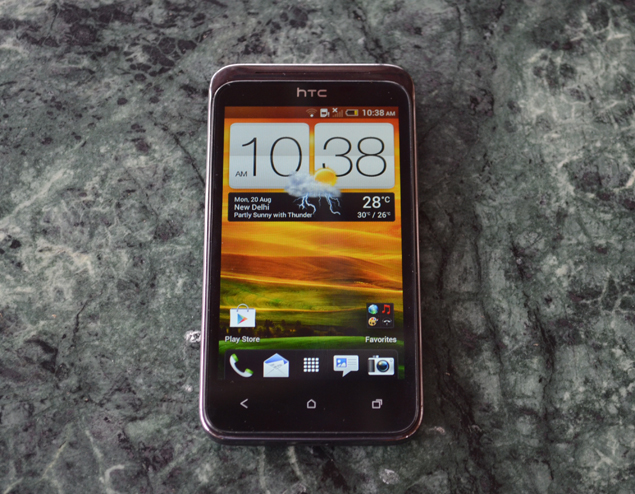
Software/ Interface
HTC
Desire VC runs on Ice Cream Sandwich and has a layer of HTC's own Sense
4.0 UI. As HTC comes with Android 4.0.3, on-board it offers features
such as Task Switcher or the Resizable Widgets, which come in pretty
handy.
HTC Sense 4.0 is a nice addition and helps in enhancing
the performance of this smartphone. This new version looks akin to HTC
Sense 3.6 but the newer version is lighter. Another addition in HTC
Sense 4.0 is that it lets you resize widgets.
There are five
customisable home screens to show app shortcuts and widgets. Users can
even view personalised shortcuts on the HTC Lock-screen.
The
keyboard on this smartphone is responsive and quite comfortable to use
in both portrait and landscape modes. There was enough room to type
accurately even while using the keyboard on portrait mode and the
accuracy too is decent.
In terms of pre-loaded apps, HTC Desire VC
packs in 7digital, car, friend Stream, flashlight, HTC Hub, Polaris
Office, SoundHound, Teeter, TuneIn Radio and Wi-Fi Hotspot.
7digital
is a Music app, which acts both as a player and MP3 music store where
one can listen and buy music. The HTC Car app launches automatically
whenever you connect the smartphone to HTC Car Kit and acts like an
in-dash unit.
Teeter is an interesting puzzle game in which the
objective is to get the ball from the start of a maze to the target
hole. To make it more challenging, there are a few holes in the path
that must be avoided.
Performance/ Battery Life
The HTC
Desire VC runs on a single core 1GHz cortex A5 Qualcomm processor, with
only 512MB of RAM, which is a bit underwhelming as most of the other
smartphones at this price point such as Sony Xperia U, Motorola Atrix 2
and Sony Xperia P are offering a dual-core processor.
When it
came to actual usage, we find that in the normal day usage, browsing the
Internet through this smartphone is a pleasurable experience and the
size of the screen really helps in that. The pages loaded quite quickly
and scrolling was convenient. However, there can be a few jerks while
trying to multitask on the smartphone.
HTC Desire VC offers ample
storage. There is 4GB of internal memory, which can be extended up to 32
GB through a microSD card. Also, the company has tied up with Dropbox
and is offering 25 GB of cloud space for two years.
Being a dual-SIM smartphone, users can run 3G on the GSM SIM while the CDMA one can support EVDO (Evolution Data Optimised).
To
help users manage between the two SIMs, HTC has a dual-SIM Manager
settings option that can help users personalise their calling
experience. The call quality on both the CDMA and GSM is decent.
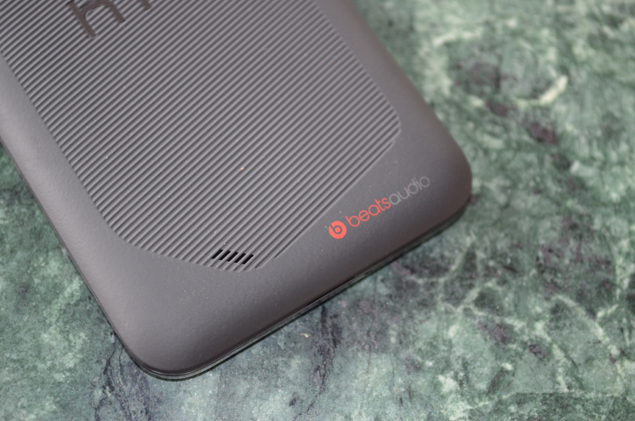
Integrated
with Beats Audio, users will expect enhanced sound quality from the HTC
Desire VC. The audio output with the bundled headphones is decent but
not so great on the loudspeakers.
What's more disappointing was
the video playback on the smartphone. The stock video player could not
even playback an MP4 file. Given the screen and the resolution, there
was so much more that HTC could have done with respect to the video
playback capabilities.
Considering that HTC Desire VC is a
dual-SIM, dual-active smartphone the 1650 mAh battery has a stiff job on
its hands. The battery just about manages to scrape through a full day
with a single charge, which is decent by any standard.
Playing
games on this smartphone is a pleasurable experience. There were no lags
in playing common games such as Temple Run Brave and Teeter.
Verdict
The
HTC Desire VC is an interesting dual-SIM smartphone as there aren't too
many smartphones that offer a combination of CDMA and GSM. The dual-SIM
market has so far been dominated by offerings from the so-called
"lesser" manufacturers, so it is good to see a premium dual-SIM
offering.
The things that go in favour of this smartphone are its
good looks and that it sports a display. On the performance front
despite having a single-core processor, this smartphone manages to do an
ok job. The Android 4.0.3 along with Sense 4.0 is a great combination.
However,
the camera on-board is average and there is no front camera on board.
Even the video playback leaves a lot to be desired.
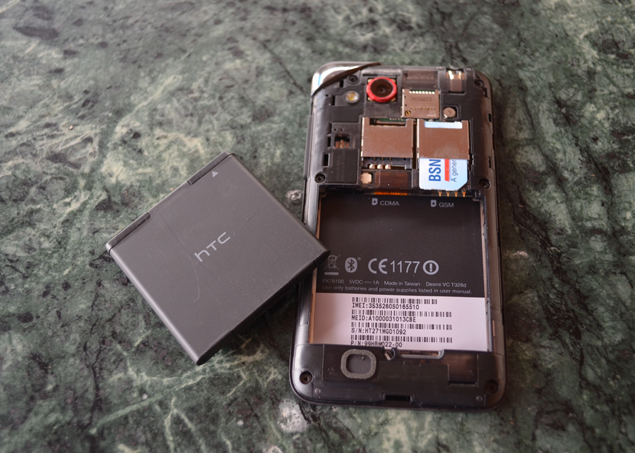
Considering
that they aren't too many interesting CDMA + GSM smartphone, HTC Desire
VC can be an interesting choice but we do feel that given the specs and
the performance, this smartphone from HTC's stable is slightly
overpriced smartphone.

HTC Desire VC in pictures
Price: Rs. 21,999
Pros
- Appealing design and comfortable to hold
- Good display
- Camera performance
- Design: 4
- Display: 3.5
- Performance: 3.5
- Software: 4
- Battery Life: 3.5
- Value for Money: 2.5
- Camera: 2.5
- Overall: 3.5
Labels
Acne
Alvin-Tan
Amy-Jackson
Anjali-Damania
Apps
AR-Rahman
Australia
Bagh-e-Jinnah-Park-Lahore
Bagh-Ibn-e-Qasim
Barcelona
Bike
BJP
Budget
Cameras
Cave-Temple-Indonesia
Chitrangada-Singh
CSK
Dark-Skin
Dead-Acacia-Trees
Deals
Dia-Mirza
Economy
Entertainments
Evelyn-Sharma
Exclusive
Food-Drink
Gaming
Gauhar-Khan
Gold-Price
Haripriya
Health
Home-Entertainments
Hotels
Hrithik-Roshan
Internet
Jobs
Kajal-Agarwal
Kangana-Ranaut
Kareena-Kapoor
Katrina-Kaif
Katy-Perry
Kingfisher
Laptops
Life-Style
London
Madhurima
Malala-Yousafzai
Malvika-Raaj
Manmohan-Singh
Maruti-Alto
Mathew-Hayden
Mobiles
Mouli-Ganguly
Moustafa-Ismail
Narenra-Modi
Obama
Oresund-Bridge
Pataudi-Palace
Piedra-Del-Penol
Priyanka-Chopra
Rahul-Gandhi
Rape
Real-Estate
Recipes
Roshni-Chopra
Sachin
Sachin-Tendulkar
Safari-Storme
Saif-Ali-Khan
Samantha
Sapporo-Snow-Festival-Japan
Sarah-Jane-Dias
Sensex
Shazahn-Padamsee
Shruti-Hassan
Social-Networking
Socotra-Island
Sony-VAIO
Sports
Steelers
Student of the Year
Sulagna-Panigrahi
Surveen-Chawla
Tablets
Taobat-Neelum-Valley
Technology
Telecom
Tragedy
Travel
Undersea-Tube-Tunnel
Vivian-Lee
Whitehaven-Beach
Whitsunday-Island
Yami-Gautam
Yash-Chopra
Yuvraj-Singh
Zarine-Khan





















